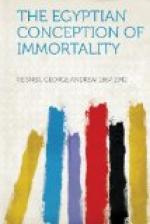The pyramid texts introduce us to three important ideas,—(1) a curious plurality of the spirit existence, (2) a condition of immortality better than that of the old underworld or Earu, and (3) most important of all, the identification of the king with Osiris according to the terms of the Osiris-Isis legend.
In all the older offering formulas it is only the ka spirit which is mentioned. Here is the body perishable and destructible; here is the life, the ka which fills every limb and vessel of the body and must, therefore, have the same form. When death comes, the ka spirit, the image of the man, remains near the body, and this spirit it was which was the object of the rites and offerings in the funerary chapel. But besides this ka, it appears for the first time that the king at any rate possesses also a soul called a ba. In later times we see that every man possessed a ba, and we learn that each god possessed several ba’s. But it is in the pyramid texts that we learn for the first time of the ba of a man, and that man is a king. When death comes, the ba takes flight in the form of a bird or whatever form it wills. All seems confused. The ka was near the body, the ka was in the field of Earu, under the earth ploughing and sowing; the ba is fluttering on the branches of the tree on earth, the ba has fled like a falcon to the heavens, and has been set as a star among the stars. The dead king lives with the gods and is fed by them. The goddesses give him the breast. He lives in the Island of Food. He lives in Earu, the Underworld, a land like Egypt, with fields and canals and flood and harvest. He shares with the gods in the offerings made in the great temples on earth.
It is quite clear that all this is an expression of dissatisfaction with the old belief in the simple duplicate world, the world of Earu under the earth. It is noteworthy that this first appears in royal tombs. These texts are written for kings alone. It is only many centuries later that the texts of the book of the dead showed similar possibilities open to the common man. This is the usual course of all advances in Egypt,— architecture, sculpture, writing, whatever gain in skill or knowledge there is, appears first in the service of the royal family. Thus, even in the conception of immortality, the new ideas, the better immortality was first thought out for the benefit of the king. The basis for




